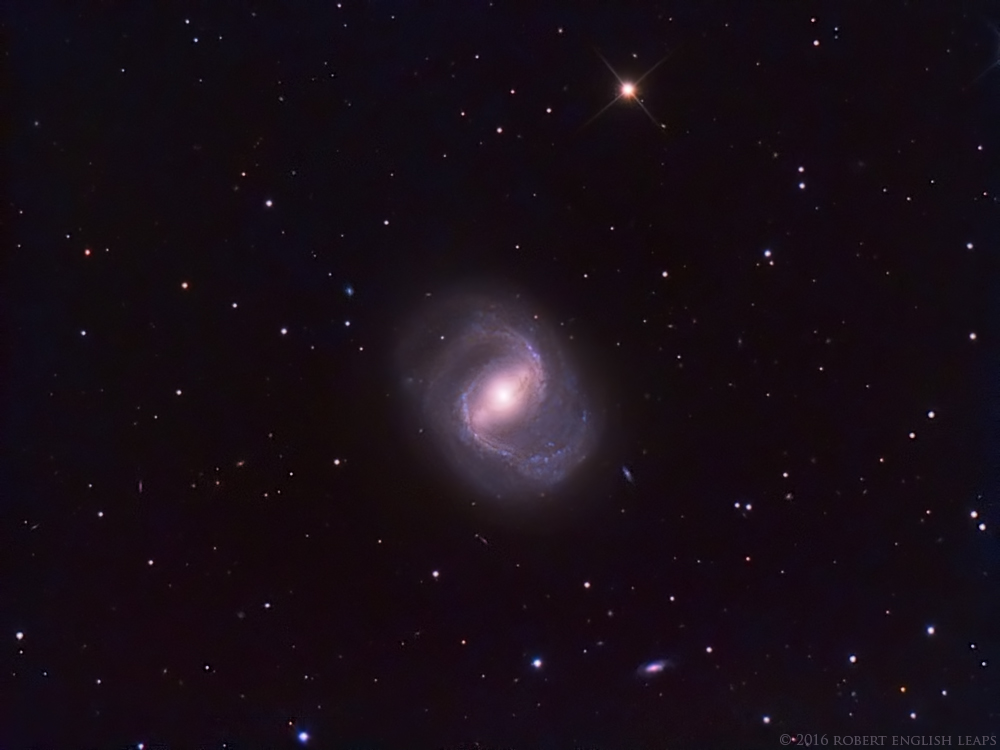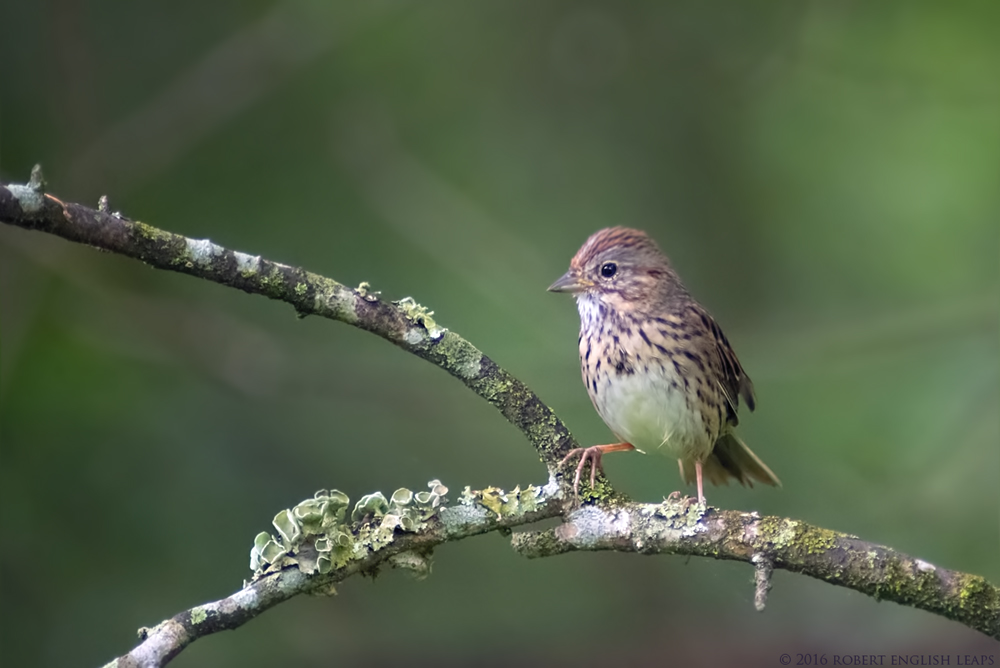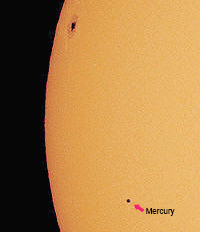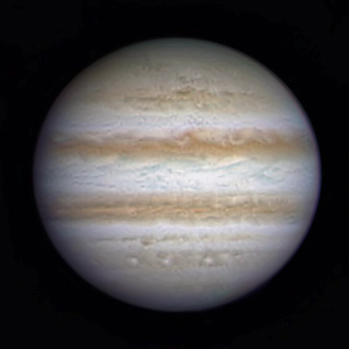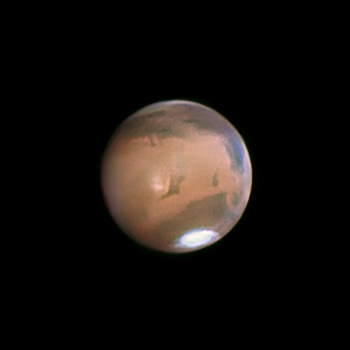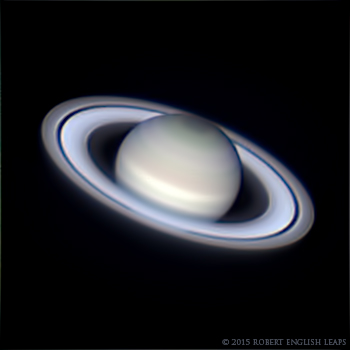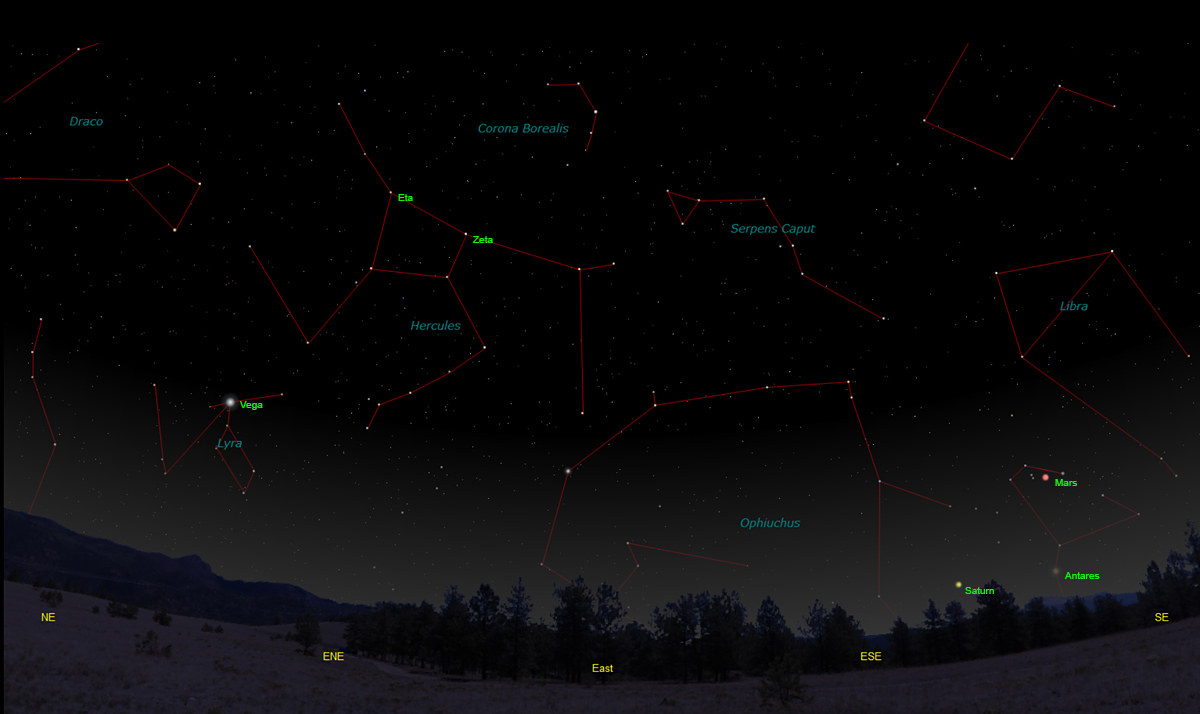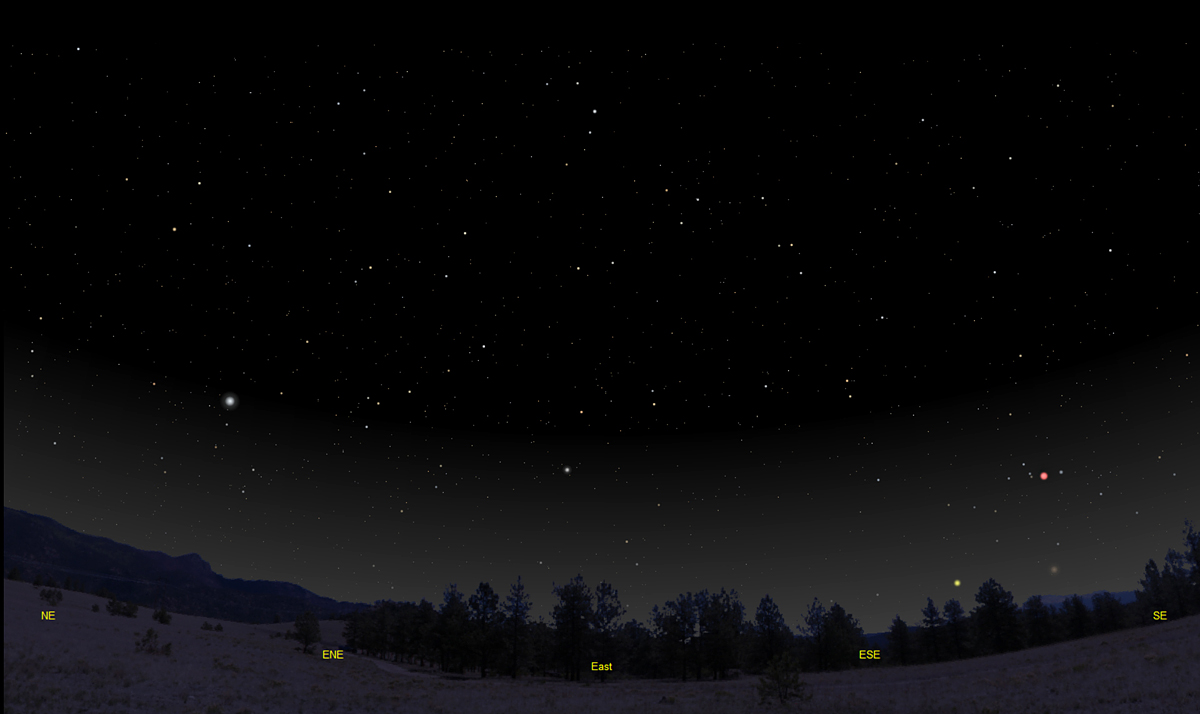The purpose of this feature is to give scout leaders, educators and naturalists an idea of some of the natural events coming up each month. We will try to cover a variety of natural events ranging from sky events to calling periods of amphibians, bird and mammal watching tips, prominent wildflowers and anything else that comes to mind. We will also note prominent constellations appearing over the eastern horizon at mid-evening each month for our area for those who would like to learn the constellations. If you have suggestions for other types of natural information you would like to see added to this calendar, let us know! Note: You can click on the hyperlinks to learn more about some of the featured items. To return to the Calendar, hit the "back" button on your browser, NOT the "back" button on the web page. All charts are available in a "printer friendly" mode, with black stars on a white background. Left clicking on each chart will take you to a printable black and white image. Please note that images on these pages are meant to be displayed at 100%. If your browser zooms into a higher magnification than that, the images may lose quality. Though we link book references to nationwide sources, we encourage you to support your local book store whenever possible.
Notes and Images From April 2016 In the years that we have been putting the Natural Calendar together each month, we have learned that there is an ebb and flow to our adventures in the natural world. Though you can work very hard in preparation, you cannot force an interesting moment. Often though, when you least expect it, the universe seems to smile on you, and something really wonderful happens. Earlier in the month we had some really frustrating moments with the weather and with our equipment. I planned on getting some images of Mars with our 20 inch Newtonian reflecting telescope. Mars is headed toward its closest approach to Earth in the last decade this month, and I really wanted to get some shots. Unfortunately, after I had assembled the big scope I ran into multiple mechanical problems that ruled out imaging, or even visual observing. There was nothing to be done except take everything back apart and lug it back indoors. The Mars train was pulling away from the station and I was still standing on the platform. This trend seemed to continue until April 28th. I noticed that a weather system that was predicted to bring cloudy skies over our area was actually going north of us, and our skies would be clear. We were still repairing our 20 inch Newtonian, but I scrambled to get the observatory open and the 12.5 inch Newtonian ready to go. I set up an observing plan on my computer for a barred spiral galaxy called Messier 91. Though not as large as many of the Messier galaxies, it looked interesting, and would be a nice challenge.
The clouds did in fact stay to our north, and I tried to make sure I took advantage of every clear moment. Another weather system was coming in the next day, and I knew the clouds would be back. The scope finished imaging the galaxy around 2:00am and spent the rest of the night taking calibration frames. Once started, the telescope runs itself, so I spent most of my time that evening just enjoying the night. Around midnight I walked back out to the scope. The air had a little chill in it and the night was still - none of our usual spring insect sounds. A Great Horned Owl called in the distance. Looking south, I was startled by how incredibly bright Mars had become! It was dazzling, like a bright red coal. The trio of Mars, Saturn and Antares, the bright red star that is the heart of the scorpion, was just stunning. Messier 91 is one of the fainter Messier galaxies. It's about 63 million light-years away, and is located just over the border of Virgo in the constellation of Coma Berenices. In a small telescope you typically just see the nucleus. To find it requires a clear dark night and a bit of patience. If you don't have a "go to" mounting, you can point your scope roughly halfway between the stars Denebola and Vindemiatrix and locate the galaxies M84 and M86, then work your way out "Markarian's Chain" to get to Messier 91. The Sky and Telescope Pocket Sky Atlas (see references below) has a special chart of the Virgo cluster of galaxies. There are probably more direct ways to find it, but it's fun hunting down some of the brightest galaxies in the Virgo Cluster.
The following morning, still a little groggy after my 2:00am bedtime, I came across this Tan Jumping Spider, Platycryptus undatus. This is a male, evidenced by the orange-tan area beneath the forward facing eyes. This area is white in females. Not long ago we photographed a female of this species on the wall of our observatory.
I photographed it on
one of the Oxeye Daisies that grow next to our garden. It's a beautiful
little jumping spider, and they show little fear of humans. They'll
readily jump onto your hand and explore your fingertips. The genus name,
Platycryptus, comes from the Greek words for "broad" "flat" and "hidden."
The species name refers to the beautiful undulating patterns on its abdomen.
This species builds silken shelters, and in the winter aggregations of as many
as fifty of these shelters have been found as continuous blankets beneath the
bark of trees. Prey include many small insects and arthropods. The following day was the spring bird count, and I participated in the count at the Owl's Hill Nature Sanctuary. I got up around 4:15am so I could get there a little early and check things out, so it was another rather short night. We had a great count, with many interesting species, among them a flock of five Baltimore Orioles in the top of one tree. Just as we were about to finish up, I noticed a sparrow that looked interesting to me. When we had walked by this area earlier in the day, we heard what we thought was a House Wren calling. When I got my binoculars on the sparrow, it all clicked. It was a Lincoln's Sparrow, and the "House Wren" we had heard earlier was actually the Lincoln's Sparrow calling. The songs of the two species are very similar!
It's a beautiful sparrow, with fine dark lines streaking across a buff-colored breast. The sides of the face are gray. Although all sightings on a bird count wind up as numbers on a list, all bird sightings are not equal. Most enjoyable are views of birds where you can really savor the beauty of the bird. We had long uninterrupted views of the Lincoln's Sparrow, and watched it sing several times. Even better, it stayed in the vicinity while I returned to our truck and got my recording setup and camera. I thought my image taking was over when it flew across the trail near the base of a rock wall in some high grass, but just before I headed back it hopped back up on a branch about 15 feet away, and I got the image above. Lincoln's Sparrows are an uncommon migrant in Tennessee, and I always feel very fortunate to enjoy the beauty of this bird and its song. Sparrows were one of the toughest groups of birds for me to learn, but they are among the groups that now bring me the most enjoyment. Their subtle but beautiful colors and intricate songs make any morning better.
Sky Events for May 2016:
Transit of Mercury: The fleet-footed planet transits the Sun on May 9th. This is the first transit of Mercury since 2006. The transit will begin at 6:12 CDT and end at 1:42pm CDT. Midpoint of the transit will occur at 9:58am CDT. Never look at the Sun without proper protection for you eyes. The small apparent size of Mercury on the Sun's face (see the image at right that we took during the 2006 transit) means that you will definitely need a telescope to see the transit. Even the briefest of looks through a telescope without a solar filter in place is enough to permanently damage your eye and even cause blindness. Always use a tight-fitting solar filter that fits in front of your objective lens or mirror. Never leave a telescope trained on the Sun unattended in a public setting.Evening Sky:
Jupiter is in Leo this month. Look for it about 58 degrees above the southwest horizon at dusk as the month begins. This month is a great time to see Jupiter and its cloud belts. If you steady your binoculars on something solid, you can often pick out several of the four Galilean satellites of Jupiter close to the planet. With a telescope, you can often glimpse some details in the clouds. These details change rapidly, and the details can look different from night to night. It's also fun to watch the Galilean satellites transit across the face of the planet, or be eclipsed by the planet's shadow. Mars is in Scorpius as the month begins, rising about 9:27pm CDT. The planet's apparent diameter is growing larger as we near its closest approach to Earth on May 30th. At the beginning of the month it's 16 arc-seconds in diameter, but grows to 18.6 arc-seconds by month's end. This means that Mars will appear larger than it has in a decade. Mars is always fascinating to view, but it takes patience to wait for the moments when the Earth's atmosphere steadies. The darker areas change shape slowly over time, and the fainter detail can be maddeningly difficult to make out. And of course Mars has a history of being a trickster in that regard.
The first of the illusory Martian "canals" appeared on maps created by the Italian astronomer Geovanni Schiaparelli in 1877. Schiaparelli called these features channels (Italian "canali") and was neutral on whether they were natural features or something constructed by intelligent beings. Others, particularly Percival Lowell, saw the linear features as an indication of intelligent life on Mars. A whole world view developed in which Mars was a dying planet, where heroic Martian engineers struggled to convey water from the poles down to the deserts that covered most of the planet. In subsequent maps the canals became much more numerous, much straighter. Some were drawn as double canals, and many oases were drawn where the canals met. Of course, not every astronomer viewing the planet saw the canals. Nathanial Green did not show them in his excellent map of 1877. Tellingly, the eagle-eyed Edward Emerson Barnard, one of greatest observers of all time, did not see them. He wrote, "I have been watching and drawing the surface of Mars. It is wonderfully full of detail. There is certainly no question about there being mountains and large, greatly elevated plateaus. To save my soul, I can't believe in the canals as Schiaparelli draws them. I see details where he has drawn none....I verily believe, for all the verifications...that the canals as depicted by Schiaparelli are a fallacy and that they will be proved so before many oppositions are past." But the belief in intelligent life on Mars became widespread. Perhaps its peak came around the end of the19th century. In 1891, the Pierre Guzman prize of 100,000 French francs was established, to be awarded to the first person to communicate with a celestial body, and to receive a response. The planet Mars was exempted from the award, as it was thought not to represent enough of a challenge! As the 20th century went on, the canals were met with more and more skepticism. The final nails in the coffin were the Mariner missions to Mars. Mariner 4 flew by Mars on July 14th and 15th, 1965. Craters were visible on the planet's surface. On seeing the images, science fiction author Isaac Asimov reportedly said to Frederik Pohl, "Craters? Why didn't we think of craters?" Mariner 9 was the first spacecraft to orbit another planet, and it was the first to show the surface of Mars well. Before the spacecraft reached Mars, Carl Sagan was in a panel discussion and talked about the Martian canals. Sagan, a skeptic, made a comment that summed up the whole canal controversy; "There is no question that the straightness of the lines is due to intelligence. The only question concerns which side of the telescope the intelligence is on." But the planet still seems to have a pull on me. Schiaparelli's nomenclature for the surface features, though altered somewhat, is beautiful and still used today. He named the surface features after features on maps of the ancient Earth. Greek myths abound. I once saw a small dark area on Mars called Nodus Alcyonius. I found that the name referred to the legend of Alcyone and Ceyx in Ovid. That led me to kingfishers, and back to our Belted Kingfisher, Ceryle Alcyon. Since, I've never looked at a kingfisher dropping off a branch and flying along the water's surface, calling, in quite the same way. And Schiaparelli did make some amazing observations. He named one frequently occurring white spot on Mars, "Nix Olympica" (translation, Olympic Snow). He noted that even when most of the other features of the planet were hidden by dust storms, Nix Olympica could still be seen. As it turns out, he was viewing the wave clouds that form over the feature now known as Olympus Mons, the highest mountain in the solar system.
Saturn is in Ophiuchus, rising around 9:58pm CDT at the beginning of the month. The tilt of the rings has now opened to 26 degrees, and the view is spectacular in any size telescope. The planet transits around 3:00am CST. Saturn is also coming to opposition, on the night of June 2nd. The globe of Saturn is now 18.4 seconds of an arc. In fact, the globe of Saturn and Mars will be almost exactly the same apparent size by the end of the month! Constellations: The views below show the sky looking east at 9:30pm CDT on May 15th. The first view shows the sky with the constellation outlined and names depicted. Star and planet names are in green. Constellation names are in blue. The second view shows the same scene without labels. A sure sign that spring is here is the rising of the bright blue-white star Vega in the early evening. Vega is the brightest star in Lyra, the Lyre, and it shines like a diamond in a small telescope. Look low in the southeast for brilliant Mars to rise, followed by Saturn and Antares. Antares means, "rival of Mars," but Mars will be much brighter than Antares this month as the Earth and Mars draw close. As spring progresses and Hercules rises higher in the sky, look for the globular cluster Messier 13 (M13), which appears like a small fuzzy patch of light about 1/3 of the distance from Eta to Zeta Hercules (see illustration below). A cluster of stars about 21,000 light years away, M13 can be made out with the naked eye in a dark country sky when the constellation is high in the sky. Binoculars will help pick it out. On Learning the Constellations: We advise learning a few constellations each month, and then following them through the seasons. Once you associate a particular constellation coming over the eastern horizon at a certain time of year, you may start thinking about it like an old friend, looking forward to its arrival each season. The stars in the evening scene above, for instance, will always be in the same place relative to the horizon at the same time and date each May. Of course, the planets do move slowly through the constellations, but with practice you will learn to identify them from their appearance. In particular, learn the brightest stars (Like Vega and Antares in the above scene looking east), for they will guide you to the fainter stars. Once you can locate the more prominent constellations, you can "branch out" to other constellations around them. It may take you a little while to get a sense of scale, to translate what you see on the computer screen or what you see on the page of a book to what you see in the sky. Look for patterns, like the stars that make up the constellation Hercules. The earth's rotation causes the constellations to appear to move across the sky just as the sun and the moon appear to do. If you go outside earlier than the time shown on the charts, the constellations will be lower to the eastern horizon. If you observe later, they will have climbed higher. As each season progresses, the earth's motion around the sun causes the constellations to appear a little farther towards the west each night for any given time of night. If you want to see where the constellations in the above figures will be on June 15th at 9:30pm CDT, you can stay up till 11:30pm CDT on May 15th and get a preview. The westward motion of the constellations is equivalent to two hours per month. Recommended: Sky & Telescope's Pocket Star Atlas is beautiful, compact star atlas. A good book to learn the constellations is Patterns in the Sky, by Hewitt-White. You may also want to check out at H. A. Rey's classic, The Stars, A New Way to See Them. For skywatching tips, an inexpensive good guide is Secrets of Stargazing, by Becky Ramotowski. A good general reference book on astronomy is the Peterson
Field Guide,
A Field Guide to the Stars and Planets, by Pasachoff. The book retails for around $14.00. The Virtual Moon Atlas is a terrific way to learn the surface features of the Moon. And it's free software. You can download the Virtual Moon Atlas here. Cartes du Ciel (described in the monthly notes above) is a great program for finding your way around the sky. It is also free, and can be downloaded here. Apps: We really love the Sky Safari Pro application described here. For upcoming events, the Sky Week application is quite nice. Both apps are available for both I-phone and Android operating systems. The newest version, Sky Safari 4, is available here. A nother great app is the Photographer's Ephemeris. Great for finding sunrise, moonrise, sunset and moonset times and the precise place on the horizon that the event will occur. Invaluable not only for planning photographs, but also nice to plan an outing to watch the full moon rise. Available for both androids and iOS.
Amphibians:
By the end of May all of Tennessee's frogs and toads are either calling or have already reached their peak calling period and are being heard less. The treefrogs are the last of our frogs and toads to start calling. Cope's Gray Treefrog and Gray Treefrogs start giving isolated calls as early as late February, and by the end of this month listen also for Bird-Voiced Treefrogs, Green Treefrogs and Barking Treefrogs. In May we also hear Fowler's Toads calling frequently, so listen for their "crying baby" call. Eastern Cricket Frogs are hitting their stride as well. Listen for a sound like two stones being tapped together. We have heard eight or more species of frogs calling on some May evenings, so it's a great time to listen. Upland Chorus Frogs and Spring Peepers continue to call. Listen for their calls to increase in pitch and quicken with the rising temperatures. Recommended: The Frogs and Toads of North America, Lang Elliott, Houghton Mifflin Co.
Archives (Remember to use the back button on your browser, NOT the back button on the web page!) Natural Calendar February 2016 Natural Calendar December 2015 Natural Calendar November 2015 Natural Calendar November 2014 Natural Calendar September 2014 Natural Calendar February 2014 Natural Calendar December 2013 Natural Calendar September 2013 Natural Calendar December 2012 Natural Calendar November 2012 Natural Calendar September 2012 Natural Calendar February 2012 Natural Calendar December 2011 Natural Calendar November 2011 Natural Calendar September 2011 Natural Calendar December 2010 Natural Calendar November 2010 Natural Calendar September 2010 Natural Calendar February 2010 Natural Calendar December 2009 Natural Calendar November 2009 Natural Calendar September 2009 Natural Calendar February 2009 Natural Calendar December 2008 Natural Calendar November 2008 Natural Calendar September 2008 Natural Calendar February 2008 Natural Calendar December 2007 Natural Calendar November 2007 Natural Calendar September 2007 Natural Calendar February 2007 Natural Calendar December 2006 Natural Calendar November 2006 Natural Calendar September 2006 Natural Calendar February 2006 Natural Calendar February 2003 Natural Calendar December 2002 Natural Calendar November 2002 Nature Notes Archives: Nature Notes was a page we published in 2001 and 2002 containing our observations about everything from the northern lights display of November 2001 to frog and salamander egg masses. Night scenes prepared with The Sky Professional from Software Bisque All images and recordings © 2016 Leaps
|
|
